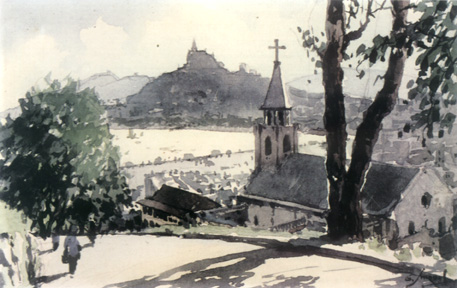§1. LANDSCAPE ART AND ARTISTS
The fascination for the representation of Landscape for its own sake does not surge spontaneously in the historical context of Western Painting. The 'early' European artists were primarily concerned with the representation of Deities and Humans, the rendering of Nature or depictions of social events being absent from the plastic expressions. When in the sixteenth century they masterfully analysed these subjects -- such as Brueghel 'the Elder' (° ca 1525/30-†1569) through his 'paysagistic portraits' -- their pictorial representations were imbued with powerful expressionistic imagery intentionally conveying pictorially suspended realms of reality and content. Traditional Chinese landscape painting evolved from radically different premises from Western artistic concepts. Sublimating a 'photographically' realistic representation, landscape has always been a fundamental theme of the repertoire of Chinese pictorial art.
The Europe of the late eighteenth and early nineteenth centuries saw the birth of Naturalism and Realism Schools which, distancing from the intellectual impassioned Romanticism of those times, claimed for a return to 'purity' against the 'frivolous artistry' of the Neo-Classical contemporary socially triumphant fashions. These new visual arts currents aimed above all at representing Nature 'as seen' by the 'noble savage'. These Schools were particularly developed in Britain where artists churned hundreds of paintings depicting rolling landscapes, bucolic peasant cottages, agricultural labourers, etc. A good painter was considered one who selected his theme well rather than a stylistic virtuoso of the brush. These are the very first steps of Landcape Painting. The subdued attitude of these painters overwhelmed by the plenitude their themes rarely propelled them to fame and noteriety. The anthitesis of these painters' detachment are the epic chromatism of William Turner (° 1775-†1851°) -- whose basic techniques were borrowed from his paysagistic northern predecessors --, the earthly allegorism of Jean-Dominique Ingres (° 1780-† 1867) and the uninhibited world of the Impressionists. For the Landscape Painters the environment had to be intellectually decoded and pictorially rendered to the general public as a regenerated and revivifying signifier of emotions, feelings and ideas. The advent of photography would revolutionarize such vision, the increasing appreciation of this media's frozen reality economically surplanting the costly skills of portrait and landscape painters.
§2. THE SEDUCTION OF THE LANDSCAPE
This exhibition -- a selection of works from the collection of the Museu Luís de Camões (Luís de Camões Museum) -- is centred on the works of four painters who sought to represent Macao in visual terms. If this city's geographical location in Southern China would not be, by itself, seductively 'exotic' enough to be meritoriously expressed in art, the confluence of cultures and the multiplicity of Eastern and Western influences and peoples were catalizing factors for the attraction to the city of Western artists. These factors of strangeness, uniqueness, irreproductibility, of etheral qualities and sensations which ardently required being visually rendered for posterity were to become artistic realities, and even more, reasons for compulsive outbursts of genius -- such as Chinnery's frantic appetite for sketching in graphite and ink, everytime and everywhere, those 'happenings', later to be occasionaly assembled within the oil compositions of his canvases.
Macao, refuge of foreigners and home of Chinese, was that 'magic' location sizzling the concordant future of humankind: a multicultural world concomitantly sheltering creeds, social mores and behaviours. The alluring power of seduction which captivated these four artists is condensed in the unique environment of this city, of this compound identity of coherence and disparity.
Above all, this album registers the relationship of four painters with a natural and human landscape and their talent for devising a genre of Landscape Painting subordinated to the embracing theme of Macao. These painters, seduced by the city's views, streets, monuments, and peoples, thankfully rendered it homage freezing its urbanity to posterity, in time and motion. Little remains of these four artist's pictorial momentoes. The recollection of past grandeurs which their works attest is to the present not only fundamentally historical visual documentation but also avenues for the recreation of an imaginary city, thus, doubly enriching their legacy's repertoire.
During the twentienth century, and up to these days others followed their paths. Macao is proud of its native painters, such as Herculano Estorninho, as well as foreign painters who settled here, such as George Smirnoff -- the Russian Konstantin Bessmertnyi--who, amongst other artists of this century, left testimonies which constitute an ample pictorial corpus. These works of art might well be crucial testimonies to the creative interpretation of their authors' contemporary history of Macao. □

Macau seen from the Conde de S. Januário's Hospital.
GEORGE SMIRNOFF (°Vladivostok, 1903-‡Hong Kong, 1947).
1945. Watercolour. 19.0 cm x 29.4 cm.
Leal Senado / Luís de Camões Museum, Macao.
In: Macau•A invenção da paisageM, ill. 120.
Revised reprint from: The Invention of Landscape, in "Macau • A invenção da paisageM: Chinnery • Watson • Borget • Smirnoff: Colecção do Museu Luís de Camões", Macau, [Exhibition Catalogue / Galeria de Exposições Temporárias do Leal Senado: 9 a 30 de Março 1996 [9th-30th March 1996], pp. 31-32 [text -- in English].
start p. 169
end p.